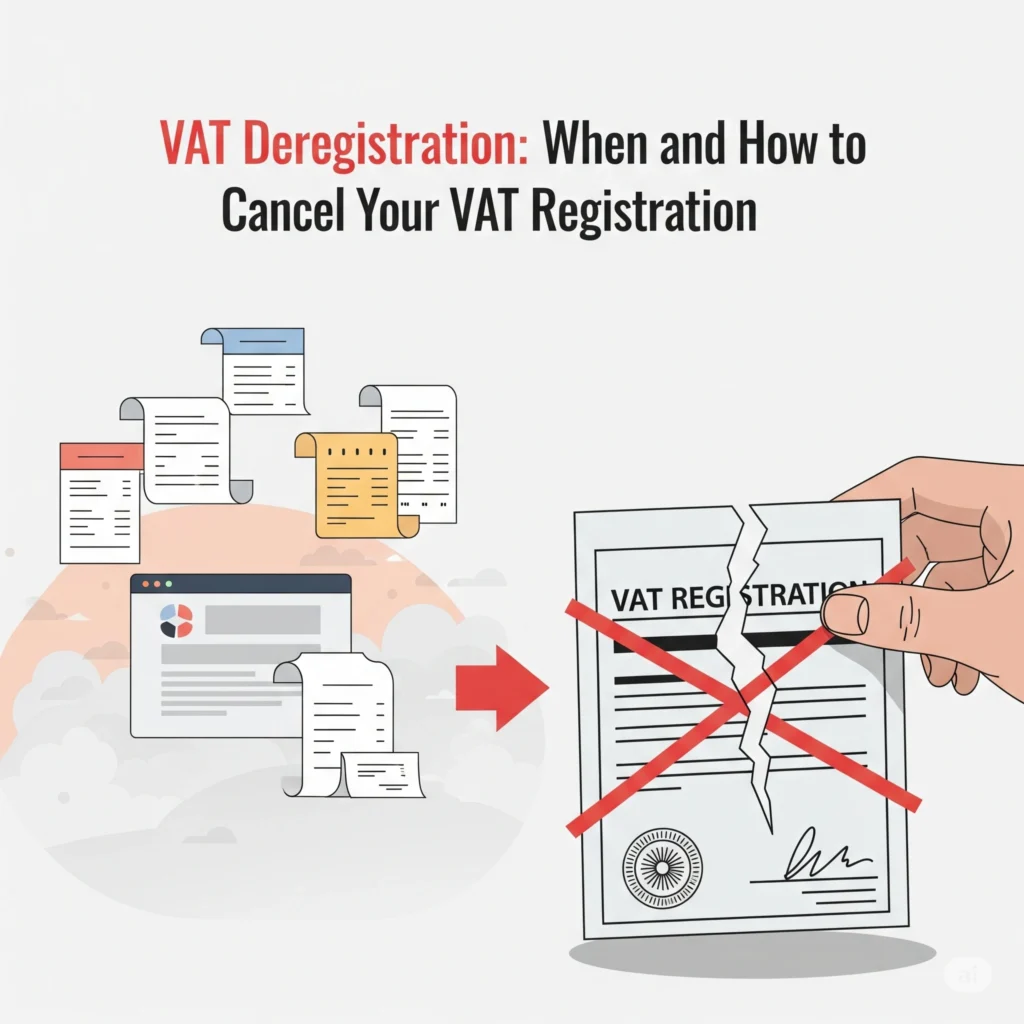VAT deregistration is a critical process for UK businesses no longer required to be VAT registered, ensuring compliance with HMRC regulations while avoiding penalties. With over 1.8 million UK businesses VAT-registered in 2024 (HMRC), understanding when and how to cancel VAT registration is essential for small businesses, sole traders, and e-commerce entities. This article outlines the triggers, methods, and post-deregistration obligations, leveraging official HMRC guidelines for clarity and authority.
When Must You Cancel VAT Registration?
You must cancel your VAT registration within 30 days if you’re no longer eligible, as failure to do so may incur penalties (Gov.uk, 2025). Key triggers include:
- Ceasing Trading: If your business stops making VAT-taxable supplies, such as a retailer closing operations.
- Joining a VAT Group: Businesses merging into a VAT group must cancel individual registrations.
- Turnover Below Threshold: If your taxable turnover falls below £88,000, you can request deregistration, unless you’re based outside the UK and supply goods/services to the UK (HMRC, 2024).
For example, a UK consultancy with turnover dropping to £70,000 after losing a major client qualifies for voluntary deregistration, streamlining tax obligations.

For more detailed information on VAT penalties and compliance, visit our comprehensive guide: VAT Penalties in the UK: How to Avoid Costly Fines.
The VAT threshold is increasing!
— Dickson Middleton (@DicksonMiddleCo) March 25, 2024
From 1 April 2024, the VAT threshold will increase from £85,000 to £90,000.
The deregistration threshold will also increase to £88,000.
Get in touch with our team today for advice!#VAT #BusinessAdvice pic.twitter.com/dS2expbLG8
How to Cancel VAT Registration
You can cancel your VAT registration online or by post, depending on your circumstances. Online cancellation is efficient for straightforward cases, while postal methods suit complex scenarios.
Cancel Online
Use the HMRC online portal if:
- You’ve stopped trading or making VAT-taxable supplies.
- Your turnover is below £88,000.
- You’re applying for an exemption (e.g., most sales are zero-rated).
You’ll need your Government Gateway ID and password. In 2023, 65% of VAT deregistrations were processed online, reducing processing time to 3 weeks (HMRC, 2024).
Cancel by Post
Use Form VAT7 for:
- Changes in legal status requiring a new VAT number.
- Business sales where the new owner doesn’t retain the VAT number.
- VAT group disbandment (submit with VAT50-51).
- Liquidation scenarios.
Download, complete, and mail Form VAT7 to HMRC’s provided address (Gov.uk, 2025). Partial completion isn’t possible, ensuring accuracy.
When You Don’t Need to Cancel
Certain scenarios do not require VAT deregistration:
- Changing Legal Status: Transfer your registration if your business structure changes (e.g., sole trader to limited company).
- Single Company in VAT Group Closing: Update the group using a VAT50-51 form.
- Joining or Creating a VAT Group: Complete a VAT50-51 form instead of cancelling (Gov.uk, 2025).
For instance, a UK e-commerce business transitioning to a limited company can retain its VAT number, ensuring continuity.
What Happens After Deregistration?
HMRC typically confirms cancellation within 3 weeks, setting the official date as when the reason for cancellation took effect (e.g., trading cessation). Key post-deregistration steps include:
- Stop Charging VAT: Cease adding VAT to invoices from the cancellation date.
- Submit Final VAT Return: Account for the period up to the cancellation date, including stock/assets with VAT over £1,000 if reclaimable (HMRC, 2024).
- Retain Records: Keep VAT records for 6 years to comply with audits.
For example, a retailer deregistering after closing must submit a final return covering unsold stock with £1,500 VAT, ensuring compliance.
Risks of Incorrect Deregistration
Failing to cancel within 30 days or continuing to charge VAT post-cancellation may lead to penalties up to 100% of unpaid tax (Gov.uk, 2025). HMRC may auto-re-register businesses that wrongly deregister, requiring retroactive VAT payments. In 2023, HMRC issued £1.6 billion in penalties for non-compliance (HMRC, 2024).
Conclusion
VAT deregistration is mandatory when eligibility ceases, with clear online and postal processes to ensure compliance. UK businesses must act within 30 days to avoid penalties, submit final returns, and retain records. Consult HMRC’s VAT Cancellation Guide for detailed instructions and use automation tools like Xero for accurate record-keeping.
Frequently Asked Questions
After submitting your deregistration request to HMRC, they will issue a VAT deregistration certificate confirming the cancellation of your VAT registration.
To deregister for VAT, you must submit a VAT7 form to HMRC either online or by post, indicating that your taxable turnover is below the registration threshold.
You must deregister for VAT if your taxable turnover falls below the £83,000 threshold (as of 2025), or if you no longer make taxable supplies.
A company may deregister for VAT if its taxable turnover falls below the threshold, if it ceases trading, or if it no longer makes VAT-taxable supplies.
Deregistering for VAT means you can no longer charge VAT on sales or reclaim VAT on purchases, and you must file a final VAT return to settle any outstanding liabilities with HMRC.